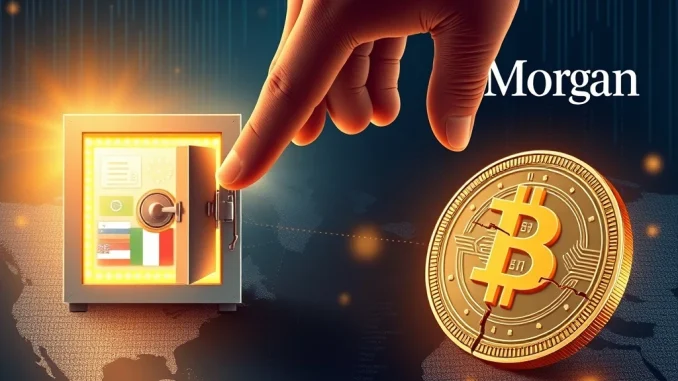
The landscape of digital finance is evolving at a breathtaking pace, with financial titans like JPMorgan at the forefront of observing and influencing these shifts. A recent report from JPMorgan, highlighted by The Block, reveals a pivotal development: a growing preference among non-U.S. regulators for tokenized bank deposits as the foundation for future digital payment infrastructure, rather than traditional stablecoins. This insight isn’t just a fleeting observation; it signals a potentially transformative direction for how money moves globally, impacting everything from cross-border transactions to everyday commerce.
Why Are Tokenized Bank Deposits Gaining Such Traction?
The concept of tokenized bank deposits might sound complex, but at its core, it’s about representing traditional bank money on a blockchain. Imagine your bank account balance, but instead of just being an entry in a ledger, it’s a digital token that can be programmed and transacted instantly on a distributed ledger technology (DLT) network. This isn’t a new form of money, but a new, more efficient way to move existing money.
- Enhanced Programmability: Unlike traditional deposits, tokenized versions can be embedded with smart contracts, enabling automated payments, escrow services, and complex financial agreements without intermediaries.
- Regulatory Clarity: Since these tokens are direct liabilities of regulated banks, they inherit the existing regulatory framework, offering a clearer path for compliance and oversight compared to novel digital assets.
- Stability and Trust: Backed by actual bank deposits, they inherently carry the trust and stability of the banking system, mitigating the volatility concerns often associated with other digital assets.
- Operational Efficiency: They promise faster settlement times, reduced costs for cross-border payments, and streamlined reconciliation processes, offering significant operational benefits for financial institutions.
This inherent alignment with existing financial regulations and the promise of enhanced efficiency are key reasons why non-U.S. regulators are looking at them favorably.
The Stablecoin Dilemma: What Are the Concerns?
For years, stablecoins have been touted as the bridge between traditional finance and the crypto world. Designed to maintain a stable value, typically pegged to a fiat currency like the U.S. dollar, they have seen explosive growth. However, their rise has also brought a wave of regulatory scrutiny, particularly outside the U.S.
JPMorgan’s report suggests that while stablecoins offer certain advantages, they also present significant challenges for regulators, including:
- Issuer Risk: The stability of a stablecoin heavily relies on the reserves held by its issuer. Concerns about the quality, liquidity, and transparency of these reserves have been a recurring theme, leading to calls for stricter audits and oversight.
- Systemic Risk: If a major stablecoin were to fail or lose its peg, it could trigger broader financial instability, especially as their usage expands into mainstream financial activities.
- Regulatory Arbitrage: The varied regulatory approaches across jurisdictions for stablecoins create opportunities for regulatory arbitrage, potentially undermining financial stability and consumer protection efforts.
- Anti-Money Laundering (AML) / Counter-Terrorism Financing (CTF): Ensuring robust AML/CTF controls for decentralized stablecoin networks remains a complex challenge for authorities.
These concerns highlight a fundamental difference in how regulators perceive the risk profiles of assets that are direct liabilities of regulated entities versus those issued by often less-regulated or entirely new entities.
JPMorgan’s Perspective: A Global Shift?
The insights from JPMorgan are particularly significant given their extensive involvement in exploring blockchain technology and digital assets, including their own JPM Coin. Their report isn’t just an observation; it reflects deep engagement with the evolving regulatory landscape and the practicalities of implementing digital payment solutions.
The report suggests that while the U.S. is still grappling with a comprehensive framework for stablecoins, many other jurisdictions are actively pursuing regulatory clarity. This clarity often leans towards models that integrate digital assets within existing regulatory perimeters, making tokenized bank deposits a more palatable option. This preference is not uniform globally but appears to be a growing trend among non-U.S. jurisdictions that prioritize financial stability and consumer protection through existing, robust regulatory mechanisms.
This doesn’t necessarily spell the end for stablecoins, but it does indicate that their future might be more tightly integrated into regulated financial institutions or subject to more stringent oversight, particularly for those aiming for broad adoption as a payment rail.
Navigating the Future of Digital Payments
The implications of this regulatory preference are far-reaching for the future of digital payments. If tokenized bank deposits become the favored mechanism, we could see a more rapid, yet controlled, integration of blockchain technology into mainstream finance. This could lead to:
- Faster Cross-Border Transactions: Imagine international payments settling in minutes, not days, with reduced fees and greater transparency.
- Innovative Financial Products: Programmable money could unlock new types of loans, bonds, and investment vehicles that are more efficient and accessible.
- Central Bank Digital Currencies (CBDCs): The rise of tokenized bank deposits could also influence the design and adoption of CBDCs, potentially offering a complementary or alternative approach to digital fiat.
However, challenges remain. Interoperability between different bank DLT networks, standardization of tokenized deposit protocols, and ensuring equitable access for smaller institutions will be critical for widespread adoption. The journey to a fully digital payment infrastructure is complex, requiring collaboration between financial institutions, technology providers, and regulators.
Regulators’ Stance: A Path to Clarity?
The explicit preference from non-U.S. regulators for tokenized bank deposits over stablecoins reflects a desire for clarity, control, and continuity. Rather than building entirely new regulatory frameworks for novel digital assets, leveraging existing banking regulations for tokenized liabilities provides a more straightforward and arguably safer path.
This approach emphasizes the importance of:
- Prudential Regulation: Ensuring that the institutions issuing these digital liabilities are well-capitalized and adhere to strict risk management standards.
- Consumer Protection: Providing clear recourse and protection for users of tokenized deposits, similar to traditional bank accounts.
- Financial Stability: Mitigating risks of runs or systemic contagion that could arise from less-regulated digital assets.
While the U.S. continues its debate, other nations appear to be forging ahead with pragmatic solutions that integrate innovation within established financial safeguards. This global divergence in regulatory approaches could shape the competitive landscape of digital finance for years to come.
In conclusion, JPMorgan’s report shines a spotlight on a significant shift in the global digital finance landscape. The growing favor for tokenized bank deposits among non-U.S. regulators over stablecoins underscores a strategic pivot towards integrating digital innovation within the robust framework of traditional banking. This isn’t merely a technical preference; it’s a profound statement about how jurisdictions envision the future of money – one that prioritizes stability, regulatory clarity, and the trusted infrastructure of regulated financial institutions. As this trend gains momentum, we can anticipate a future where digital payments are not just faster and more efficient, but also inherently more secure and seamlessly integrated into the global financial system, setting a new standard for how we transact in the digital age.
Frequently Asked Questions (FAQs)
Q1: What exactly are tokenized bank deposits?
Tokenized bank deposits are a digital representation of traditional fiat money held in a commercial bank account, issued on a distributed ledger technology (DLT) platform. They are a direct liability of the issuing bank, meaning they are backed one-to-one by actual bank deposits, inheriting the security and regulatory oversight of the banking system.
Q2: How do tokenized bank deposits differ from stablecoins?
While both aim to maintain a stable value, the key difference lies in their issuer and regulatory status. Tokenized bank deposits are issued by regulated commercial banks and are direct liabilities, falling under existing banking regulations. Stablecoins, on the other hand, are typically issued by non-bank entities, and their regulatory oversight can vary significantly, often raising concerns about reserve transparency and systemic risk.
Q3: Why are non-U.S. regulators preferring tokenized bank deposits?
Non-U.S. regulators often prefer tokenized bank deposits due to their inherent regulatory clarity and alignment with existing financial frameworks. Since they are bank liabilities, they fit seamlessly into established prudential regulations, anti-money laundering (AML) laws, and consumer protection measures, reducing the need for entirely new regulatory paradigms.
Q4: What are the potential benefits of widespread adoption of tokenized bank deposits?
Widespread adoption could lead to significant improvements in the efficiency of financial transactions, including faster and cheaper cross-border payments, enhanced programmability of money through smart contracts, and reduced settlement risks. It could also foster innovation in financial products and services within a regulated environment.
Q5: Does this mean stablecoins will disappear?
Not necessarily. While regulators may prefer tokenized bank deposits for core digital payment infrastructure, stablecoins could continue to play a role in other areas, particularly within the broader cryptocurrency ecosystem or for specific use cases. However, their future may involve more stringent regulation, potentially pushing issuers to adopt practices closer to those of regulated financial institutions.
Q6: What role does JPMorgan play in this discussion?
JPMorgan is a major global financial institution actively exploring blockchain and digital assets, including its own JPM Coin. Their reports and insights are based on extensive research, engagement with regulators, and practical experience in developing digital payment solutions, making their observations highly influential in the financial industry.



